My Teriyaki Pork Balls recipe uses thin slices of pork rolled up in bite-size morsels. Pan-fried and finished in a delectable teriyaki sauce, these easy meatballs are one of our family‘s favorites. They‘re ideal for a weeknight meal and ready in 30 minutes!

Living in the US, I encounter the word “teriyaki” a lot. In case you don’t know what teriyaki means? Teriyaki is a way of Japanese cooking. “Teri” means luster and “yaki” means to grill.
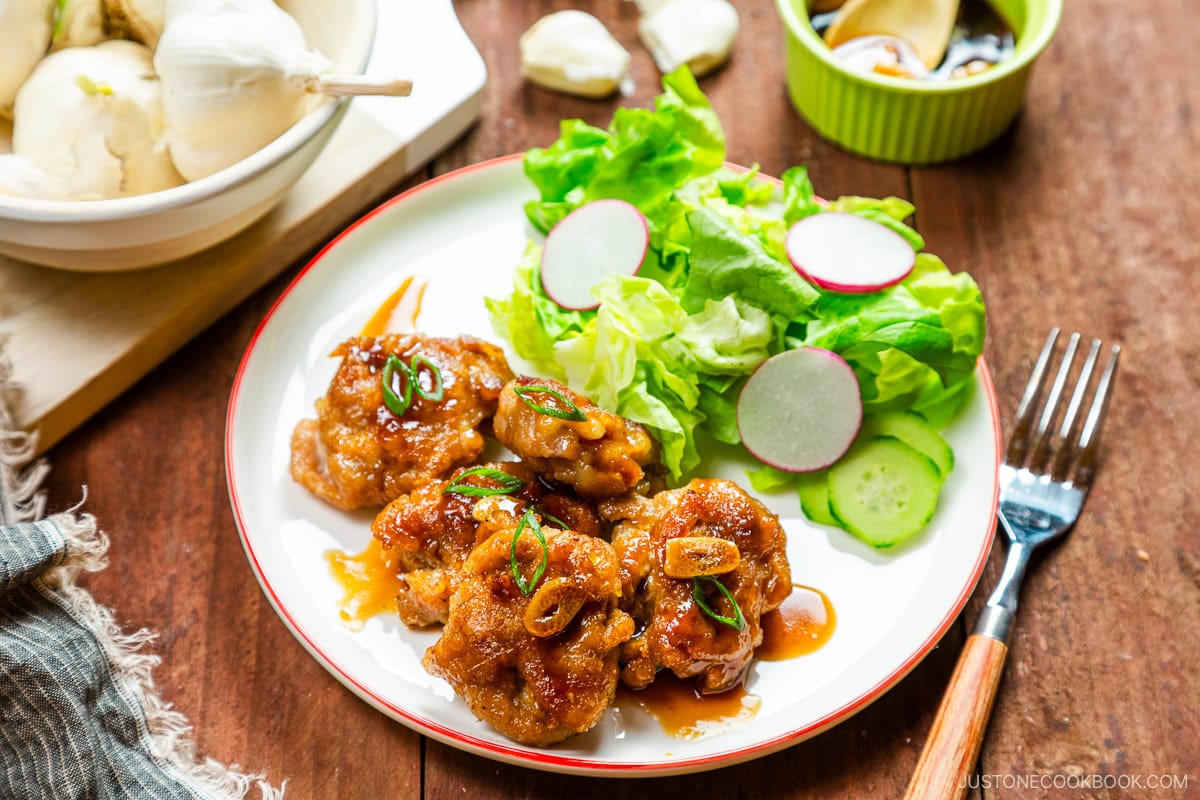
The key ingredient to make teriyaki sauce is mirin, which creates luster to ingredients. The authentic teriyaki sauce is very easy to make. It’s a combination of soy sauce, cooking sake, mirin, and sugar. Each family has a different ratio, but my home is usually 1/1/1 (soy sauce/cooking sake/Mirin + sugar). Depending on the ingredients I use, I change my ratio, adjusting soy sauce or sugar.
I hope you enjoy this recipe!
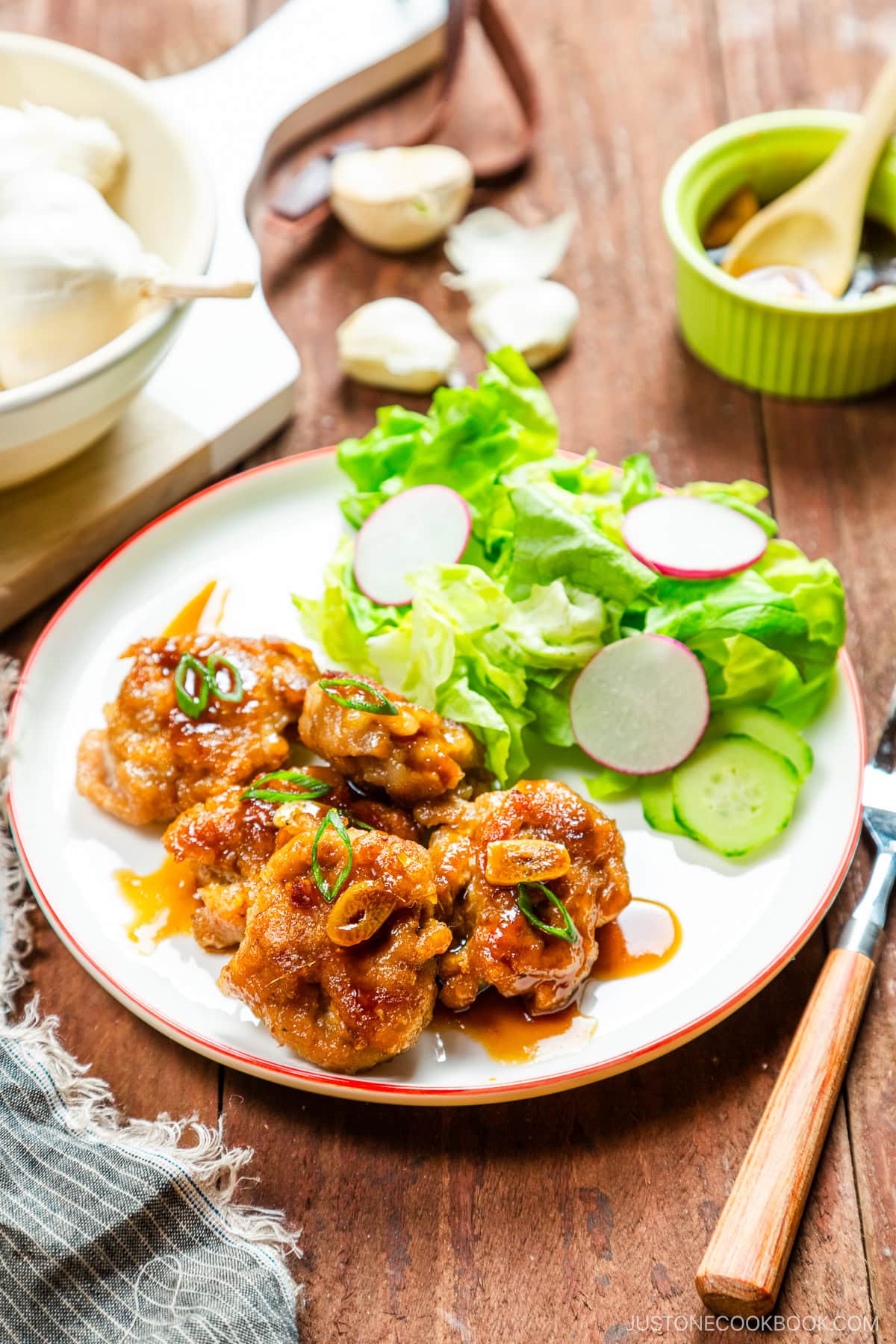
Wish to learn more about Japanese cooking? Sign up for our free newsletter to receive cooking tips & recipe updates! And stay in touch with me on Facebook, Pinterest, YouTube, and Instagram.

Teriyaki Pork Balls
Ingredients
For the Meatballs
- 1 Tbsp sake
- 1 Tbsp potato starch or cornstarch
- ¾ lb thinly sliced pork (I use the komagire cut from a Japanese grocery store; you can thinly slice your own meat)
For Coating
- 4 Tbsp potato starch or cornstarch
For Cooking
- 1 Tbsp toasted sesame oil
For the Teriyaki Sauce
For the Garnish
- 1 green onion/scallion (finely chopped)
Instructions
- Gather all the ingredients. In a small bowl, combine the teriyaki sauce ingredients: ½ tsp ginger (grated, with juice), 2 cloves garlic (thinly sliced), 2 Tbsp sake, 2 Tbsp soy sauce, 1 Tbsp mirin, 1 Tbsp sugar, and 2 Tbsp water. Mix well. In a separate medium bowl, mix 1 Tbsp sake and 1 Tbsp potato starch or cornstarch. Add ¾ lb thinly sliced pork and rub well with your hands to coat.
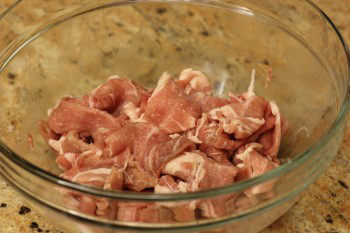
- Make bite-size meatballs with the marinated meat and place on a plate. Evenly coat the meatballs with 4 Tbsp potato starch or cornstarch.
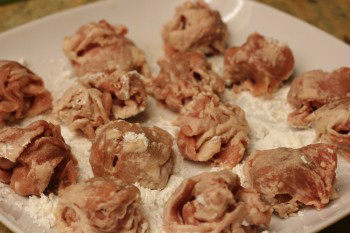
- In a large skillet, heat 1 Tbsp toasted sesame oil over medium-high heat. Gently place the meatballs on the hot skillet and cook until the bottom side is browned. Flip and cook the other side until browned.
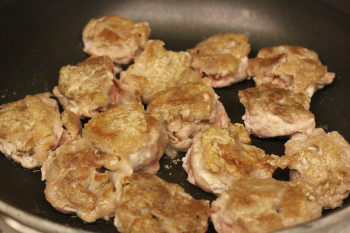
- Reduce the heat to medium. Add the teriyaki sauce to the skillet and shake to mix everything. Cook, covered, for 5 minutes. Flip the pork balls occasionally to coat them with the sauce.
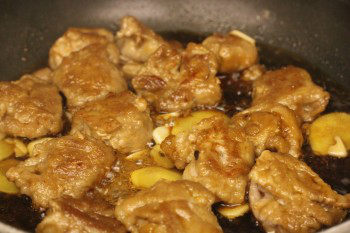
To Serve
- Transfer to a serving platter and drizzle with the pan sauce. Garnish on top with 1 green onion/scallion (finely chopped) and serve immediately.

To Store
- Keep the leftovers in an airtight container and store in the refrigerator for up to 3 days and in the freezer for a month.
Nutrition
Editor’s Note: This post was originally published on January 19, 2011. It was updated with new images in August 2014.
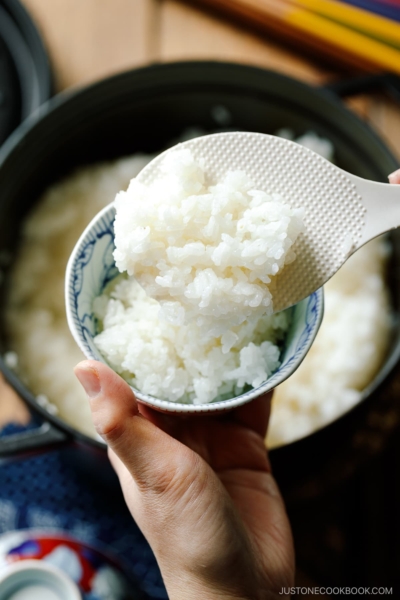
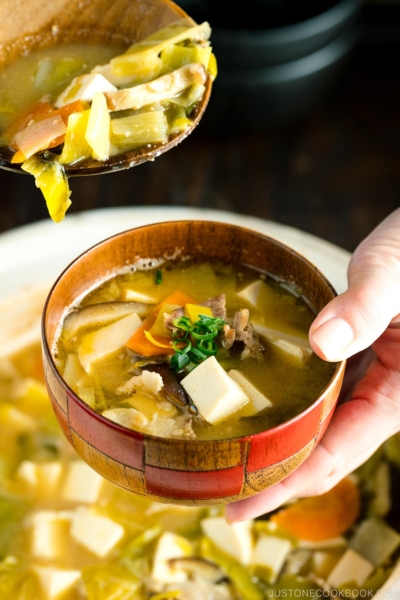
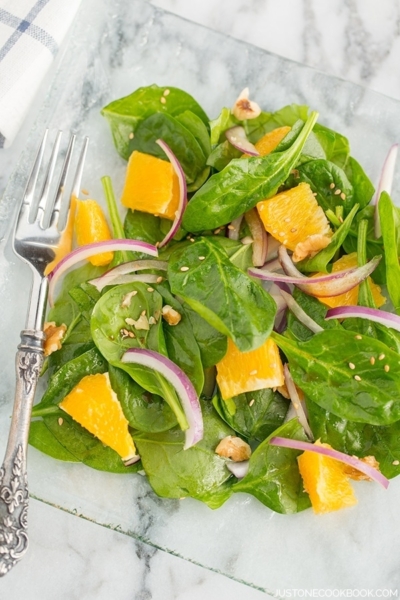
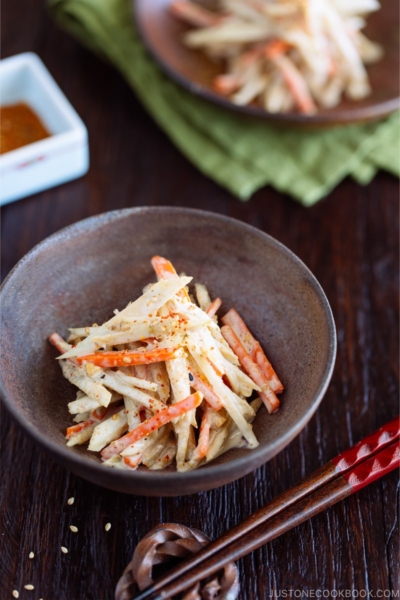




Hi. Which part of pork i should use for this recipe?
Hello, Haruka! Thank you for trying Nami’s recipe!
For this recipe, you can use pork loin or other well-marbled, thinly sliced meat. Hopefully, this helps!
Any reason one couldn’t use ground pork instead of sliced?
Hi Lesley! You can use ground pork if you like. Japanese households often have sliced meat, so we have varieties of dishes using them. Here I wanted to introduce that you can use thinly sliced meat to make meatballs. 🙂
Hi, I absolutely love your recipes. Would this be ok for a bento the next day?
Thank you!
Hi Rachael! Sure, my kids love this for bento too! 🙂 Happy to hear you enjoy my recipes! xo
This recipe was delicious! I scaled up 3x to feed my family of five, so I used ground pork instead and baked at 450 for 25-30 mins. I reduced sauce on stovetop after cooking and poured over cooked meat.
Hi Chloe! Hmm sounds delicious! I’m so happy you adapted this recipe to fit your family. Thank you for your kind feedback. 🙂
These were excellent, thank you for the great recipe!
Hi Elizabeth! Thank you for trying this recipe! So happy to hear you enjoyed this recipe. 🙂 xo
Hi. Do you know what cut of pork I could use besides the Komagire cut. I have access to a Korean grocery store, but the pork there is very thinly sliced. Thanks. Leigh
Hi Leigh! Don’t worry about komagire cut – I mentioned that so that readers who go to Japanese supermarkets can get this particular cut. 🙂 The Korean store’s thinly-sliced pork is great. It’s better if there are some fat. Well-marbled thinly sliced meat is nice too, but not necessary (they are great for shabu shabu etc). 🙂
Hi Nami,
Would it be okay to use potato starch instead of cornstarch in this recipe?
Thanks again for your wonderful recipes 🙂
Hi Mrs.Sata! Yes, I use both corn starch and potato starch depends on availability in my pantry. Hope you like this easy and delicious recipe! 🙂
Good to know!
I’m so, so grateful for your blog. I saw your link for your mashed potato teriyaki pork roll recipe above–that’s what we’re having tonight. I’ll most likely make the pork balls later this week.
Thank you!!
Hi Mrs. Sata! I love that dish! Hope you enjoy it as much as my family does. Thank you so much for following my blog. I’m so happy you enjoy it. 🙂
Hi Nami 🙂 I have been waiting to try one of your teriyaki recipes and I FINALLY found an asian grocer that sold sake and mirin! But when I brought it home I had no chicken, only prawns. So I decided to use your 1:1:1 guide to make teriyaki prawn stirfry instead. It failed. Watery and definitely no lustre (;~;) Could you maybe give me some hints on using teriyaki sauce? This was my first try.
Hi Noora! I’m glad to hear you found sake and mirin!
First of all I want to check if you coat the prawns with corn starch (potato starch would work too). That corn starch will make the sauce thicker, so it’s important.
Secondly, the ratio of prawns and the sauce matters too. You mentioned watery and no luster, so I assume you had more sauce. Reducing the sauce by cooking longer will help to make the sauce thicker and increase luster. But at the same time prawns get too hard so you need to be careful.
1 (soy sauce) : 1 (sake) : 1 (mirin+sugar) usually works for quick sauce, but I have other variations depending on the recipes such as
Chicken Teriyaki: https://www.justonecookbook.com/recipes/chicken-teriyaki/
Beef Teriyaki: https://www.justonecookbook.com/recipes/beef-teriyaki/
Mashed Potato Teriyaki Pork Rolls: https://www.justonecookbook.com/recipes/mashed-potato-teriyaki-pork-rolls/ (vinegar in it)
Depending on amount of main ingredients, adjust the portion so it won’t be too liquid. You can always add more, but it’s harder to reduce the liquid without over cooking the meat/seafood.
Hope this helps! 🙂
Thanks for the tips Nami, I will try them out for my next attempt 🙂 Even though it was watery my family still loved the flavours, I will work on thickening up the sauce
Thank you, Noora! 🙂
Hi,
I want to ask you what is the difference between sake and cooking sake? also is it different with rice cooking wine and chinese cooking wine? thanks in advance
Hi Tania! Thank you for asking – I just edited the recipe and changed to sake, because I’ve been using regular (drinking) sake for cooking food (but back then I was using cooking sake).
You can read about the difference here:
https://www.justonecookbook.com/pantry/sake/
I’m not sure what is rice cooking wine. I thought it’s Chinese wine, but then I googled and Mirin came up. I’ve never said “rice cooking wine” for mirin, but if that’s what you are asking about, you can read about details here:
https://www.justonecookbook.com/pantry/mirin/
I assume Chinese cooking wine is like sake for Japanese cooking? Hope this helps!
Hey Nami! – I love this website! I love the colorful photos and easy instructions! I have a question on this recipe, can yo alternate the meat on this dish instead of pork? I was not sure if you can substitute another type of meat.. Thank you!!
Hi Bing!
Thanks for coming to my website! Sure you can replace sliced pork with chicken thighs/breasts or beef, or even white fish fillet. Hope you like it!